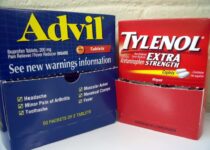What is the Best Muscle Relaxant for Back Pain?
 About 80 percent of people will get low back pain during their lifetime. About 1 in 3 patients will be prescribed a muscle relaxant. The best muscle relaxants for back pain are cyclobenzaprine (Flexeril), methocarbamol (Robaxin), carisoprodol (Soma), or tizanidine (Zanaflex). But are muscle relaxants safe? And just as important, are they effective for back pain?
About 80 percent of people will get low back pain during their lifetime. About 1 in 3 patients will be prescribed a muscle relaxant. The best muscle relaxants for back pain are cyclobenzaprine (Flexeril), methocarbamol (Robaxin), carisoprodol (Soma), or tizanidine (Zanaflex). But are muscle relaxants safe? And just as important, are they effective for back pain?
If you have ever had back pain or currently have lower back spasms right now, then this article will help you decide what are the best treatments for your back pain, and whether you should or should not use a muscle relaxant.
In this article, we’ll cover:
- What is a muscle relaxant?
- Should I take a muscle relaxant first for back pain?
- Do muscle relaxants help back pain?
- What is the safest muscle relaxant?
- The Best Muscle Relaxants for Back Pain
What is a muscle relaxant?
Muscle relaxants or muscle relaxers are prescription medications used to relieve pain by relaxing the muscles. They are used for all sorts of muscle spasms including back pain.
Some of the most common muscle relaxants include:
- Cyclobenzaprine (Flexeril)
- Carisopordol (Soma)
- Methocarbamol (Robaxin)
- Tizanidine (Zanaflex)
- Chlorzoxazone (Parafon Forte)
- Metaxalone (Skelaxin)
- Orphenadrine
Should I take a Muscle Relaxant First for Back Pain?
No, you should not take a muscle relaxant first for back pain. Muscle relaxants have lots of side effects and are not as effective as NSAIDs such as Naproxen (Aleve) or Ibuprofen (Advil; Motrin). To learn more about NSAIDs for back pain, click on this article: Is Ibuprofen or Naproxen Better for Back Pain?
If ibuprofen or naproxen do not help with your back pain after a week, you may want to ask your doctor about prescribing you a muscle relaxant such as cyclobenzaprine (Flexeril).
You can also combine a muscle relaxant with an NSAID (ibuprofen or naproxen), but it is unclear whether the combination works better than taking these medications by themselves.
The rest of this article will discuss the effectiveness and safety of muscle relaxants.
Do Muscle Relaxers Help Back Pain?
The short answer is Yes. Muscle relaxers do help relieve back pain.
According to one study:
- “Muscle relaxants are effective in the management of non-specific low back pain, but the adverse effects require that they be used with caution.”
So muscle relaxants are effective, but they make you sleepy. We will discuss the side effects of muscle relaxants later in this article.
The Best Muscle Relaxants
There is some evidence that Cyclobenzaprine (Flexeril), Carisoprodol (Soma), Methocarbamol (Robaxin), and Tizanidine (Zanaflex) work better than the other muscle relaxants.
According to one study:
- “There is fair evidence that cyclobenzaprine, carisoprodol, orphenadrine, and tizanidine are effective compared to placebo in patients with musculoskeletal conditions (primarily acute back or neck pain).”
Cyclobenzaprine (Flexeril) Effectiveness for Back Pain
Cyclobenzaprine (Flexeril) is a great first choice for a muscle relaxant for back pain. According to the same study:
- “Cyclobenzaprine has been evaluated in the most clinical trials and has consistently been found to be effective.”
Cyclobenzaprine has more evidence than other muscle relaxants for relieving muscle pain.
For more information on cyclobenzaprine, click here.
What is the Safest Muscle Relaxer?
While all muscle relaxants have side effects, a good first-choice for back pain is cyclobenzaprine (Flexeril).
Cyclobenzaprine has the most evidence for muscle pain and it is not as addictive as other muscle relaxers such as carisoprodol (Soma).
Methocarbamol (Robaxin) and Metaxalone (Skelaxin) may make you less sleepy than other muscle relaxants. But these muscle relaxants have less evidence than cyclobenzaprine. They also may be more expensive.
Side Effects of Muscle Relaxants
The most common side effects of muscle relaxants are sleepiness and dizziness.
Because muscle relaxants make you sleepy, you may want to take an NSAID (ibuprofen or naproxen) during the day and a muscle relaxant at night before bed.
Methocarbamol (Robaxin) and Metaxalone (Skelaxin) may make you less sleepy than other muscle relaxants. Thus, methocarbamol and metaxalone can be taken during the day.
Below are a list of precautions before taking a muscle relaxant:
- Do NOT take a muscle relaxant while driving or working since it can make you sleepy.
- Do NOT take a muscle relaxant if you are over the age of 65 because it can make you dizzy and put you at risk of falling.
- Do NOT take carisoprodol (Soma) if you have a substance abuse history because this muscle relaxant is more addictive than other ones.
- Do NOT take a muscle relaxant with alcohol since this combination can give you breathing problems.
- Do NOT take muscle relaxants with anti-anxiety/sleep medications called benzodiazepines such as alprazolam (Xanax), lorazepam (Ativan), etc. This combination can make it difficult to breathe.
- Do NOT take muscle relaxants with opioid pain medications such as oxycodone, morphine, hydrocodone, etc. This combination can make it difficult to breathe.
- Do NOT take muscle relaxants if you have kidney or liver disease.
Carisoprodol (Soma) side effects
The most common side effects of carisoprodol are:
- Sleepiness
- “High” feeling
- Addictive potential
For more information on carisoprodol, click here.
Chlorzoxazone (Parafon Forte DSC, Lorzone) side effects
The most common side effects of chlorzoxazone are:
- Urine discoloration (orange, red, purple)
- Rare liver toxicity
For more information on chlorzoxazone, click here.
Cyclobenzaprine (Flexeril) side effects
The most common side effects of cyclobenzaprine are:
- Sleepiness
- Dry Mouth
- Has drug interactions with antidepressants (SSRIs, SNRIs, tricyclic antidepressants)
- Risk of falls in people older than 65 years of age
For more information on cyclobenzaprine, click here.
Methocarbamol (Robaxin) side effects
The most common side effects of methocarbamol are:
- Urine discoloration (brown, brown-black, green)
For more information on methocarbamol, click here.
Metaxalone (Skelaxin) side effects
The most common side effects of metaxalone are:
- Has drug interactions the antidepressant medications (SSRIs, SNRIs, tricyclic antidepressants)
For more information on metaxalone, click here.
Orphenadrine side effects
The most common side effects of orphenadrine are:
- Sleepiness
- Dry mouth
- Difficulty urinating
- “High” feeling
- Addictive potential
For more information on orphenadrine, click here.
Tizanidine (Zanaflex) side effects
The most common side effects of tizanidine are:
- Sleepiness
- Low blood pressure
- Withdrawal symptoms: Do not stop tizanidine abruptly if you have been taking this drug for a long time. Ask your doctor how you can slowly decrease your dose.
- Many drug interactions (ciprofloxacin, fluvoxamine, oral contraceptives, famotidine, acyclovir): Please talk to your pharmacist if you are not sure whether your medications interact with tizanidine.
- Rare liver toxicity
- Rare heart rhythm disorders
For more information on tizanidine, click here.
How Long Should You Take a Muscle Relaxant?
You should use a muscle relaxant for up to one week (two weeks at most).
Muscle relaxants cause a lot of drowsiness and so they are used for short-term, usually at bedtime.
Also, muscle relaxants have not been studied for long-term use.
So, if you do not see any benefit after taking a muscle relaxant for 1 week, you should probably stop it and talk to your doctor.
The Best Muscle Relaxants for Back Pain
Muscle relaxants should only be used if NSAIDs (like naproxen or ibuprofen) are not enough for your back pain.
You should only take a muscle relaxant for about one to two weeks since they have side effects and have not been studied for long-term use.
Also do not take muscle relaxants with alcohol, opioid pain medications, or anti-anxiety drugs that make you sleepy (lorazepam, alprazolam, etc.). Combining these drugs with muscle relaxants can make your breathing more difficult.
The best muscle relaxant for back pain is Cyclobenzaprine (Flexeril) since it has the most evidence. It does cause sleepiness, however, so do not use it while working, driving, or if you are at risk of falls (like in the elderly).
A close second is Methocarbamol (Robaxin), which I have personally used, since this drug does not cause sleepiness. It may be more expensive though.
If you recently hurt your back, read this article: How to Relieve Sudden Back Pain.


